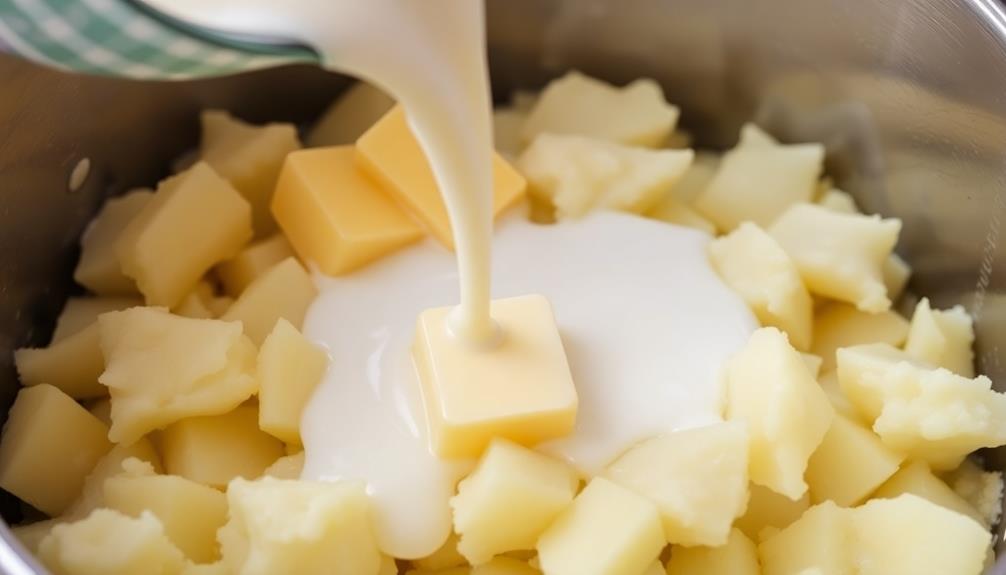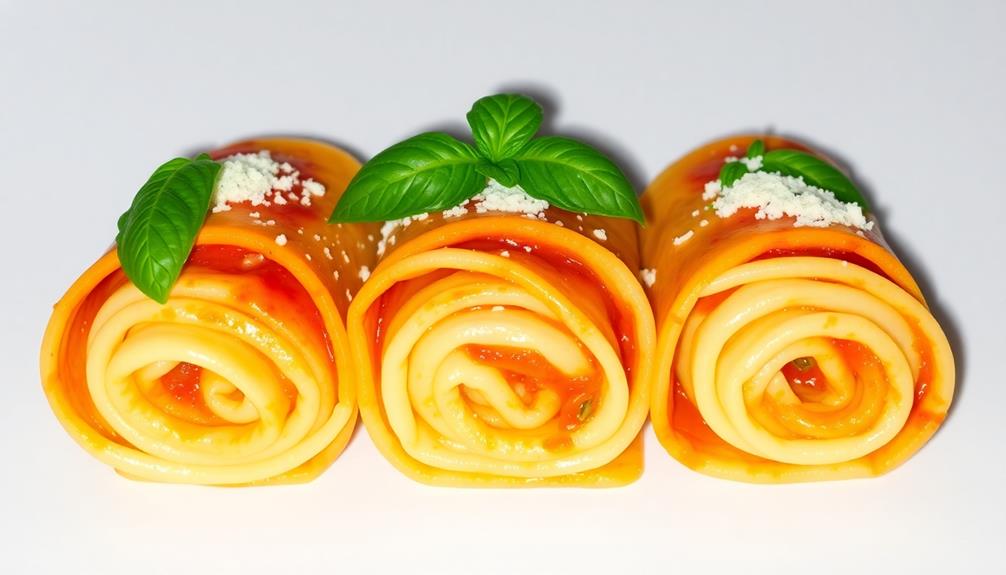Mashed potatoes have a rich and fascinating history dating back to the 16th century when they were first introduced to Europe from the Andes. Once considered food for the poor, these fluffy, creamy spuds soon became a beloved staple across all social classes. Over the years, the recipe has evolved, with the addition of butter, milk, and seasonings. Today, mashed potatoes remain a cherished comfort food, often served at family gatherings and holiday meals. To make the perfect batch, you'll need starchy potatoes, a few simple ingredients, and a little bit of mashing magic. But that's just the start – there's more to discover about these versatile taters.
Key Takeaways
- Mashed potatoes were first introduced to Europe in the 16th century from the Andes region of South America.
- Ideal potato varieties for mashed potatoes are starchy types like Russet or Yukon Gold.
- The basic ingredients for classic mashed potatoes include potatoes, milk, butter, salt, and pepper.
- The cooking process involves boiling the potatoes until fork-tender, then mashing them to achieve a smooth consistency.
- Mashed potatoes can be customized by incorporating additional ingredients like cheese, chives, or roasted garlic for enhanced flavor.
History
Mashed potatoes have a long and storied history, dating back to the 16th century when they were first introduced to Europe from the Andes region of South America.
Originally, these humble tubers were seen as food for the poor, but as time passed, mashed potatoes became a beloved dish among all social classes.
During the 18th century, the recipe for mashed potatoes evolved, with the addition of butter, milk, and seasonings.
This combination created the rich, creamy texture we know and love today. As the potato's popularity grew, it became a staple in many European households, eventually making its way to the United States in the early 19th century.
Today, mashed potatoes remain a beloved comfort food, enjoyed at family gatherings, holiday meals, and as a simple, satisfying side dish.
From their humble beginnings to their current status as a culinary classic, the history of mashed potatoes is a testament to the enduring appeal of this versatile and delicious food.
Recipe
Mashed potatoes are a classic side dish that can complement a wide variety of meals. They're easy to prepare and can be customized to suit individual tastes. Whether you prefer them creamy, chunky, or with added ingredients, mashed potatoes are a versatile and comforting dish.
The key to making delicious mashed potatoes is to start with the right type of potato. Starchy potatoes, such as Russet or Yukon Gold, are ideal as they tend to become fluffy and light when mashed. Avoid watery or low-starch potatoes, as they can result in a gummy or dense texture.
- 4 pounds Russet or Yukon Gold potatoes, peeled and cut into 1-inch pieces
- 1 cup milk
- 4 tablespoons unsalted butter
- 1 teaspoon salt
- 1/4 teaspoon black pepper
Bring a large pot of salted water to a boil. Add the potato pieces and cook until fork-tender, about 15-20 minutes. Drain the potatoes in a colander and return them to the pot.
Add the milk and butter, and mash the potatoes using a potato masher or an electric mixer until smooth and creamy. Season with salt and pepper, and adjust the seasoning to taste.
For best results, serve the mashed potatoes hot and fresh. They can be kept warm in a slow cooker or covered in the pot until ready to serve.
For a richer flavor, consider adding grated cheese, chopped chives, or roasted garlic to the mashed potatoes. Experiment with different seasonings and mix-ins to find your perfect mashed potato recipe.
Cooking Steps
Alright, let's get cooking!
First, you'll need to peel and dice those potatoes. Once they're all chopped up, it's time to boil the potato chunks until they're nice and soft.
After that, you'll want to drain the cooked potatoes and mash them up real good.
Step 1. Peel and Dice Potatoes

Typically, you'll want to start by peeling and dicing the potatoes. Use a sharp knife or a vegetable peeler to carefully remove the skin. Be sure to wash the potatoes thoroughly under running water to remove any dirt or debris.
Once the potatoes are peeled, place them on a cutting board and use the knife to dice them into small, evenly-sized pieces. This will help ensure that they cook evenly when you boil them. As you're dicing, try to keep the pieces around 1 inch in size. This will give you the perfect texture for your mashed potatoes.
Cutting the potatoes into smaller pieces also helps them cook faster, so you'll spend less time waiting for them to become tender. After dicing, place the potatoes in a large pot and cover them with cold water. Now you're ready to move on to the next step in the process of making delicious mashed potatoes.
Step 2. Boil the Potato Chunks

Once the potato chunks are prepared, bring a large pot of salted water to a boil over high heat. Carefully add the potato pieces to the boiling water, making sure they're fully submerged.
Let the potatoes cook at a steady boil, stirring occasionally, until they're fork-tender, about 15-20 minutes.
To check if they're done, poke a potato chunk with a fork. If the fork easily slides in and out, the potatoes are ready. Avoid overcooking, as that can make the potatoes watery and difficult to mash.
When the potatoes are cooked through, carefully drain them in a colander. Make sure to reserve a cup of the starchy cooking water – you'll need it later for mashing.
Return the drained potato chunks to the empty pot and let them sit for a minute or two to allow any excess moisture to evaporate.
Now you're ready to mash and finish your delicious homemade mashed potatoes!
Step 3. Drain the Cooked Potatoes

Once the potatoes are cooked through, carefully drain them in a colander. Hold the colander over the sink and gently pour out the hot water. Be careful not to burn your hands – the potatoes will be piping hot!
Tilt the colander to make sure all the water drains out. You don't want any extra moisture left behind, as that can make your mashed potatoes watery.
With the potatoes drained, it's time to start mashing. Transfer the cooked and drained potatoes to a large bowl. Using a potato masher or a fork, gently mash the potatoes, breaking them down into a smooth and creamy texture.
Don't over-mash, or your potatoes will become gluey. Add in your desired seasonings, like butter, milk, salt, and pepper.
Continue mashing and stirring until you've reached your desired consistency. Now your mashed potatoes are ready to be served and enjoyed!
Step 4. Mash the Cooked Potatoes

With the potatoes drained, transfer them to a large bowl.
Using a potato masher, press down on the potatoes and mash them up. Keep mashing until the potatoes are smooth and creamy, without any lumps.
As you mash, you can add a few tablespoons of butter to make the mashed potatoes extra rich and flavorful. Be gentle, as you don't want to overmix and make the potatoes gummy.
Once the butter has melted in, you can stir in a splash of warm milk or cream. This will make the mashed potatoes light and fluffy.
Continue mashing and stirring until you've reached your desired consistency. Season with salt and pepper to taste.
The mashed potatoes are now ready to serve! They pair perfectly with roasted meats, stews, or simply enjoyed on their own.
Step 5. Add Butter and Milk

Add a pat of butter to the mashed potatoes and let it melt in. Gently stir the butter until it's fully incorporated, creating a rich and creamy texture.
Next, pour in a splash of milk and continue stirring. Add more milk a little at a time, mixing thoroughly after each addition, until the potatoes reach your desired consistency. They should be smooth and velvety, not lumpy or dry.
Taste the potatoes and season with salt and pepper as needed. The butter and milk will mellow out the starchiness of the potatoes, giving them a delightful flavor. Once the potatoes are well-seasoned, transfer them to a serving dish and garnish with chopped chives for a pop of color and extra flavor. These mashed potatoes will be the perfect side dish for any meal, complementing everything from roast chicken to grilled steak. And for dessert, be sure to try out our delicious cheesecake bites recipe for a sweet ending to your meal.
Be careful not to overmix, as that can make the potatoes gluey. Maintain a light hand for the best, fluffiest mashed potatoes.
Now they're ready to serve alongside your main dish or as the star of the meal. Enjoy!
Final Thoughts
Mashed potatoes are a beloved side dish that can elevate any meal. Whether you're enjoying them alongside a juicy steak, a roast chicken, or your favorite comfort food, these creamy, smooth potatoes are sure to delight your taste buds.
With the right techniques, you can make mashed potatoes that are truly exceptional. As you've learned, adding butter and milk is the key to achieving the perfect texture and flavor.
But don't stop there! Consider experimenting with different herbs, spices, or even roasted garlic to take your mashed potatoes to the next level. The possibilities are endless, so feel free to get creative and find your signature blend.
Frequently Asked Questions
How Long Do Mashed Potatoes Last in the Refrigerator?
Leftover mashed potatoes can typically last 3-4 days in the refrigerator when stored properly in an airtight container. However, the exact shelf life may vary depending on the ingredients used and storage conditions.
Can You Freeze Mashed Potatoes?
You can definitely freeze mashed potatoes! They'll keep well in the freezer for up to 3 months. Just be sure to let them cool completely before portioning and freezing for best results.
What Is the Best Way to Reheat Mashed Potatoes?
To reheat mashed potatoes, you can use the microwave, oven, or stovetop. For the microwave, heat in short bursts, stirring frequently. In the oven, bake at 350°F until heated through. On the stovetop, heat gently, stirring constantly to prevent scorching.
Can You Make Mashed Potatoes Ahead of Time?
Yes, you can make mashed potatoes ahead of time. Simply refrigerate them in an airtight container for up to 3 days. When ready to serve, reheat them gently on the stove or in the microwave, adding a splash of milk or cream to loosen them up.
What Are Some Creative Ways to Use Leftover Mashed Potatoes?
You can get creative with your leftover mashed potatoes! Try using them as a topping for shepherd's pie, making potato pancakes, or even mixing them into your breakfast scramble. The possibilities are endless when you get inventive with those tasty spuds.
Conclusion
Mashed potatoes are a classic comfort food that'll have your taste buds dancing with joy! Creamy, fluffy, and oh-so-satisfying, they're the perfect side dish to complete any meal. Whether you're whipping them up for a family dinner or a cozy night in, these spuds are sure to bring a smile to your face. So, what are you waiting for? Grab your masher and let's get mashing!









